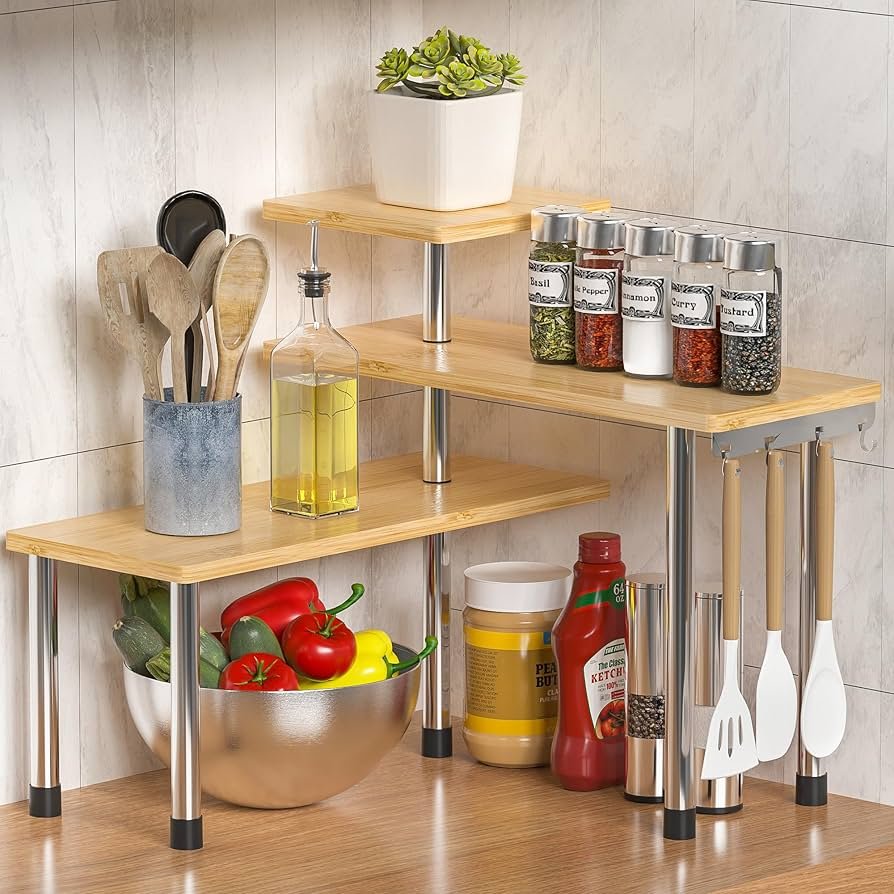Tired of digging through cluttered drawers or losing track of your pantry staples? A well-organized kitchen doesn’t just look good—it can dramatically improve your efficiency, reduce waste, and even inspire you to cook more often. Whether you have a spacious kitchen or a tiny galley setup, these 14 genius kitchen organization ideas will help you create a functional, tidy, and stress-free space.
1. Use Clear Storage Containers

Switching to clear storage containers is one of the simplest yet most effective ways to organize your pantry. These containers let you easily see what you have on hand, making grocery shopping more efficient and preventing duplicates or forgotten items that expire. Uniform containers also eliminate the chaos of mismatched packaging, creating a more visually appealing pantry.
Opt for airtight containers to keep dry goods like flour, sugar, rice, and pasta fresh for longer. Many come with stackable designs, which allow you to maximize vertical space on pantry shelves. Label each container clearly with the contents and expiration date so everything stays organized and you never have to guess.
Clear storage containers are also kid- and guest-friendly. Everyone can find snacks or staples without asking where things are. By creating a “zone” system—like baking, breakfast, or snacks—you make your pantry intuitive and easy to navigate for the whole household.
2. Install Pull-Out Cabinet Drawers
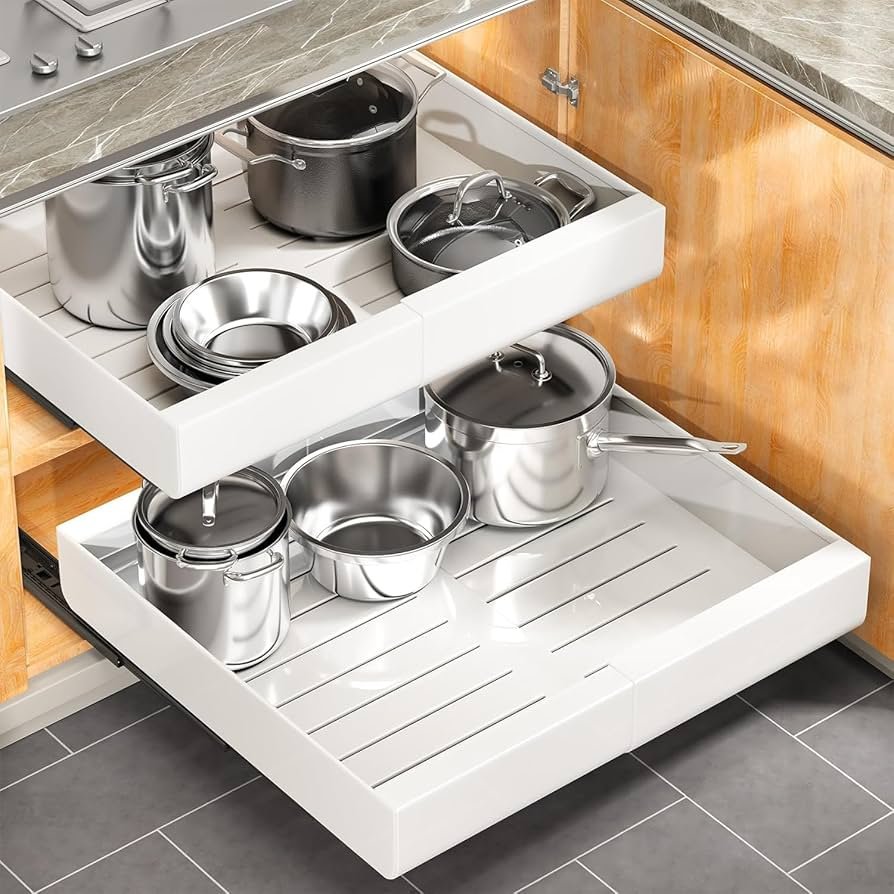
If you constantly find yourself digging around the back of lower cabinets, pull-out drawers are a total game-changer. These slide-out trays bring everything into full view, making it easy to access pots, pans, mixing bowls, and even cleaning supplies. They’re particularly helpful in deep cabinets that otherwise become black holes for forgotten items.
Pull-out drawers can be installed as DIY kits or by a professional if you want a more custom solution. Some drawers come with dividers or tiered layers to help you separate items by use or size. Once installed, you’ll wonder how you ever lived without them—they instantly upgrade the function of any kitchen without requiring a full remodel.
These drawers also make organizing your kitchen more ergonomic. No more bending over and blindly reaching to the back of a dark cabinet. Instead, you can see and reach everything in seconds, which speeds up prep and cleanup time dramatically.
3. Add a Lazy Susan
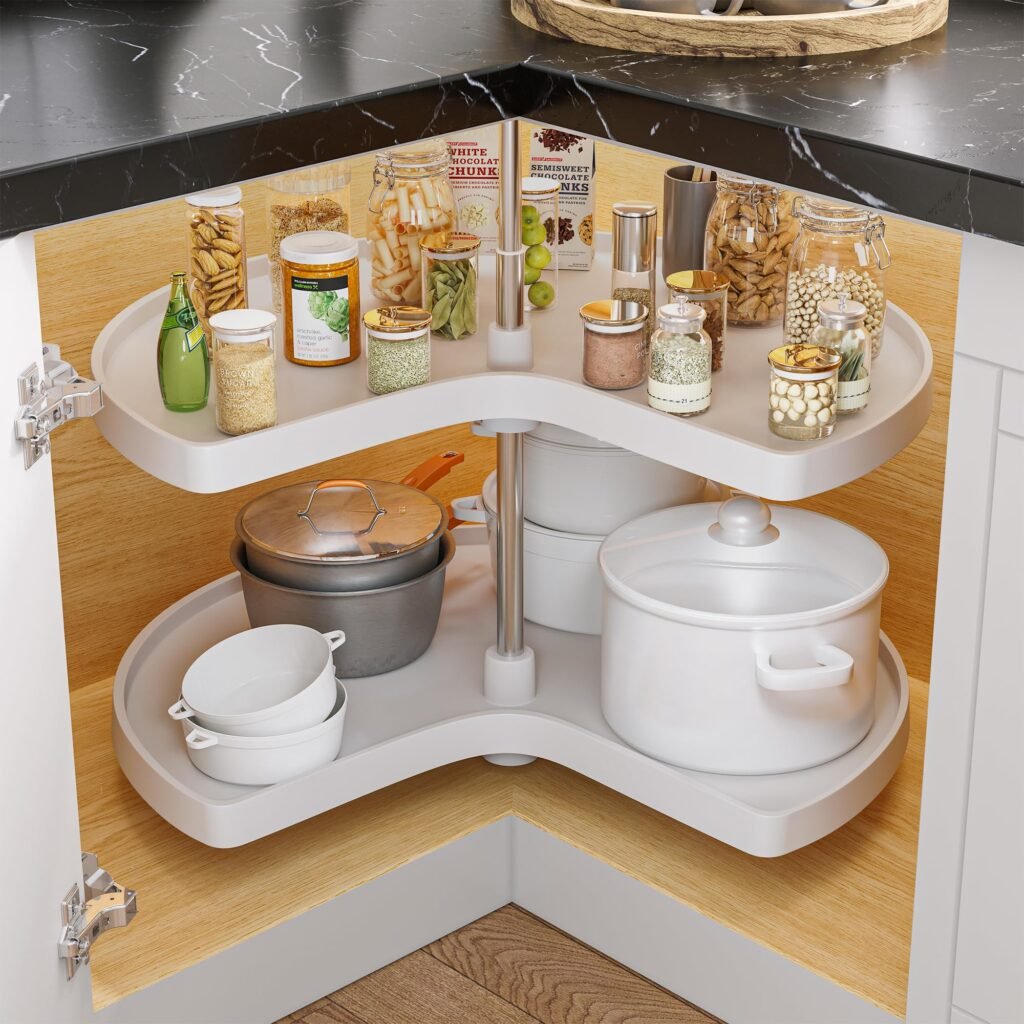
A Lazy Susan isn’t just for dining tables—this spinning turntable is a brilliant solution for organizing corner cabinets and pantries. With just a quick spin, you can access oils, condiments, spices, and snacks that would otherwise be lost in the back. It’s ideal for deep or hard-to-reach shelves that typically collect clutter.
Lazy Susans come in various sizes and materials, including wood, plastic, or metal. Some even feature multiple tiers for double the storage. You can place one in your fridge, under the sink, or even in upper cabinets to make better use of space and improve accessibility.
Using a Lazy Susan can also help you keep track of your inventory. Instead of overbuying because you didn’t realize you already had three jars of cumin, a quick turn will show you everything at a glance. It adds both function and a fun touch of motion to your kitchen organization strategy.
4. Use Tiered Shelf Organizers
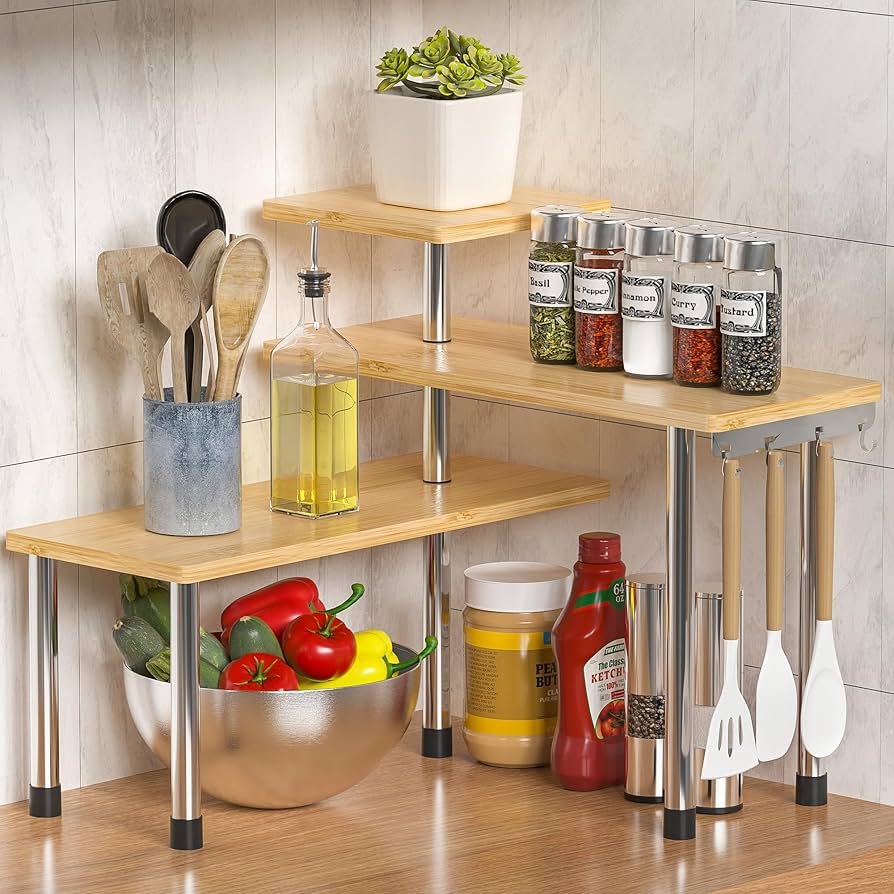
Tiered shelf organizers, also known as “stadium shelves,” are perfect for displaying canned goods, spice jars, and other small containers. These stepped organizers let you see items in the back without removing everything in front. They maximize both visibility and space efficiency, especially in deep shelves or cabinets.
When used in your pantry, tiered shelves can help prevent forgotten food and expired items. You’ll be able to do a quick visual scan and instantly know what’s available. It’s an easy way to bring grocery store-level organization to your home kitchen with minimal effort.
Many versions are expandable or adjustable to fit your shelf size perfectly. You can use them in a variety of places, from under the sink to spice cabinets to fridge shelves. Group like items together (soups, vegetables, sauces), and you’ll save time and reduce the chance of waste during meal prep.
5. Invest in Drawer Dividers
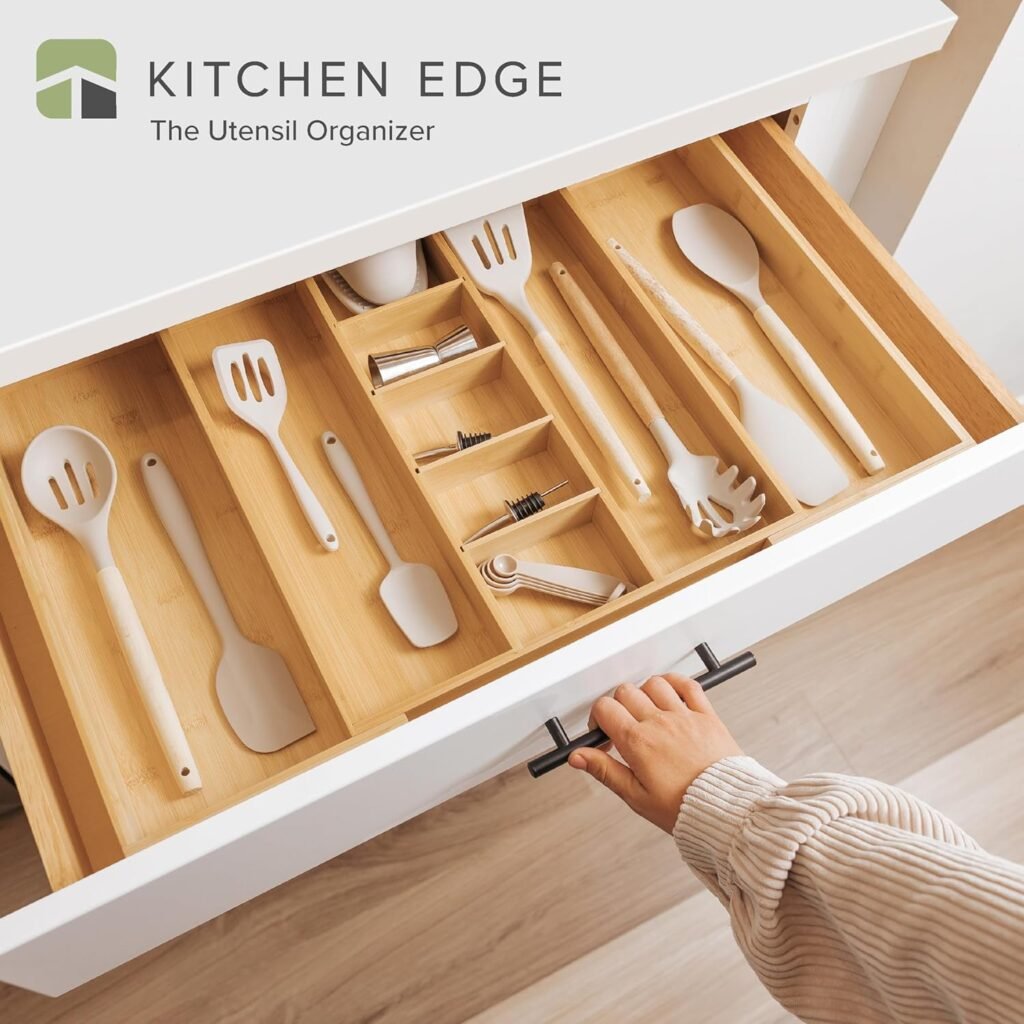
Drawer dividers are essential for anyone tired of rummaging through chaotic drawers to find a single whisk or measuring spoon. These handy tools segment your drawers into specific zones, making it easy to store utensils, tools, and gadgets without overlap. With a place for everything, your kitchen stays neater and more efficient.
Dividers come in a variety of materials, such as bamboo, plastic, or metal, and many are expandable to fit your drawer’s exact dimensions. Use them in wide drawers to create custom compartments for spatulas, peelers, and thermometers, or in smaller drawers for forks, knives, and spoons.
Not only do drawer dividers help reduce visual clutter, but they also protect your utensils from damage. When items are stacked and tangled, they can get scratched or broken. Dividers keep everything in place, making it easier to see what you have and retrieve it quickly.
6. Use a Knife Dock or In-Drawer Knife Block
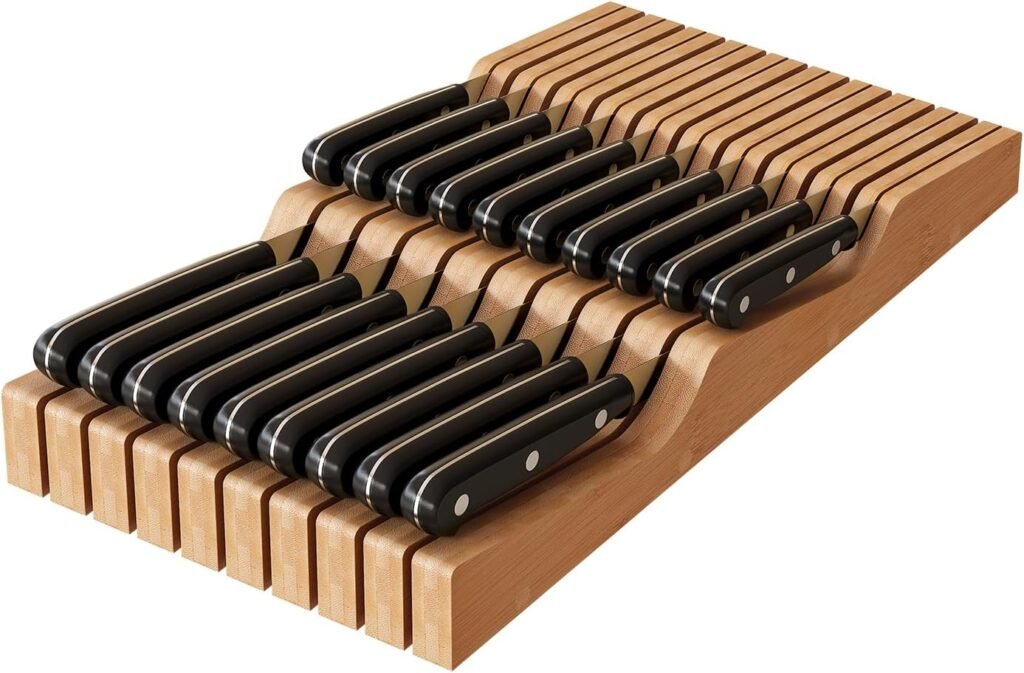
A knife dock or in-drawer knife block is a sleek and safe alternative to storing knives loosely in a drawer or on a countertop block. These inserts are designed to hold each knife securely, reducing the risk of injury and preserving the sharpness of the blades. It’s a great space-saving solution for small kitchens with limited counter space.
In-drawer knife organizers are typically made from wood or soft plastic and are designed to fit most standard kitchen drawers. You simply slide your knives into the slots, and they stay put—even when the drawer opens and closes. This eliminates the jumbled mess that often happens in drawers without dividers.
Besides the aesthetic and safety benefits, keeping knives in a dock protects their edges better than tossing them into a drawer or even storing them on a magnetic strip where they might get knocked around. It’s a small upgrade with big benefits in terms of both organization and kitchen safety.
7. Vertical File Sorters for Baking Sheets
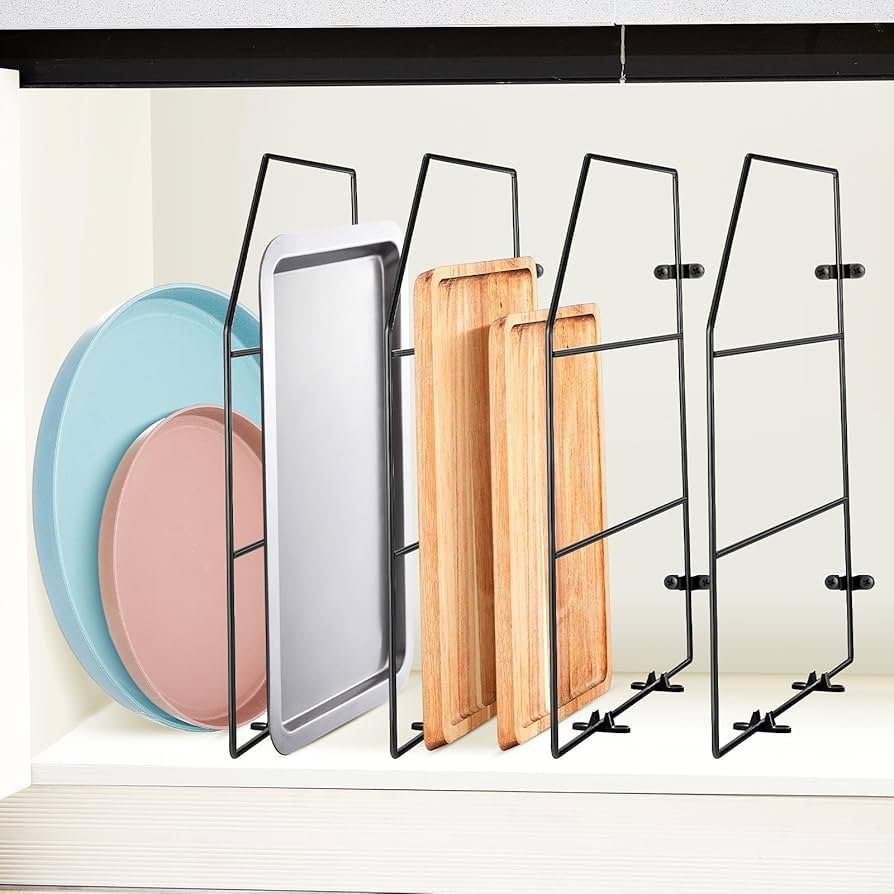
Repurposing office file sorters as kitchen organizers is an ingenious way to keep baking sheets, cutting boards, and platters upright and easily accessible. Instead of stacking them horizontally, which makes it a hassle to grab the one on the bottom, vertical storage lets you pull out just what you need.
Simply place the sorter inside a lower cabinet or on a pantry shelf. Each slot can hold a single item, keeping everything separate and preventing scratches or chips. This also works well for muffin tins, cooling racks, and pizza stones—any flat item that tends to be awkwardly stored.
This hack is not only budget-friendly but incredibly functional. It creates a “library” of baking tools that are easier to browse, access, and return. Plus, it clears up space for other bulky items and makes your kitchen feel more professional and organized.
8. Mount a Pegboard Wall
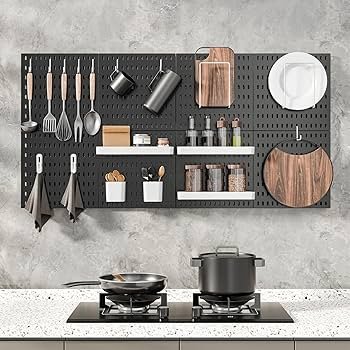
A pegboard wall adds a rustic, functional flair to your kitchen and lets you customize your storage based on your needs. Originally popular in workshops, pegboards have been embraced in modern kitchens as a way to hang pots, pans, utensils, and even decorative elements.
With a few hooks, shelves, and baskets, you can create a storage station that’s easy to change whenever you like. Hang it near your prep area to keep your go-to tools within arm’s reach, or make it a focal point by painting it a bold color and using it to display stylish cookware.
This vertical storage solution is perfect for small kitchens or renters who want a big impact without drilling into cabinets. Pegboards are also a smart way to free up drawer and counter space, leaving your kitchen less cluttered and more inviting.
9. Add Under-Shelf Baskets
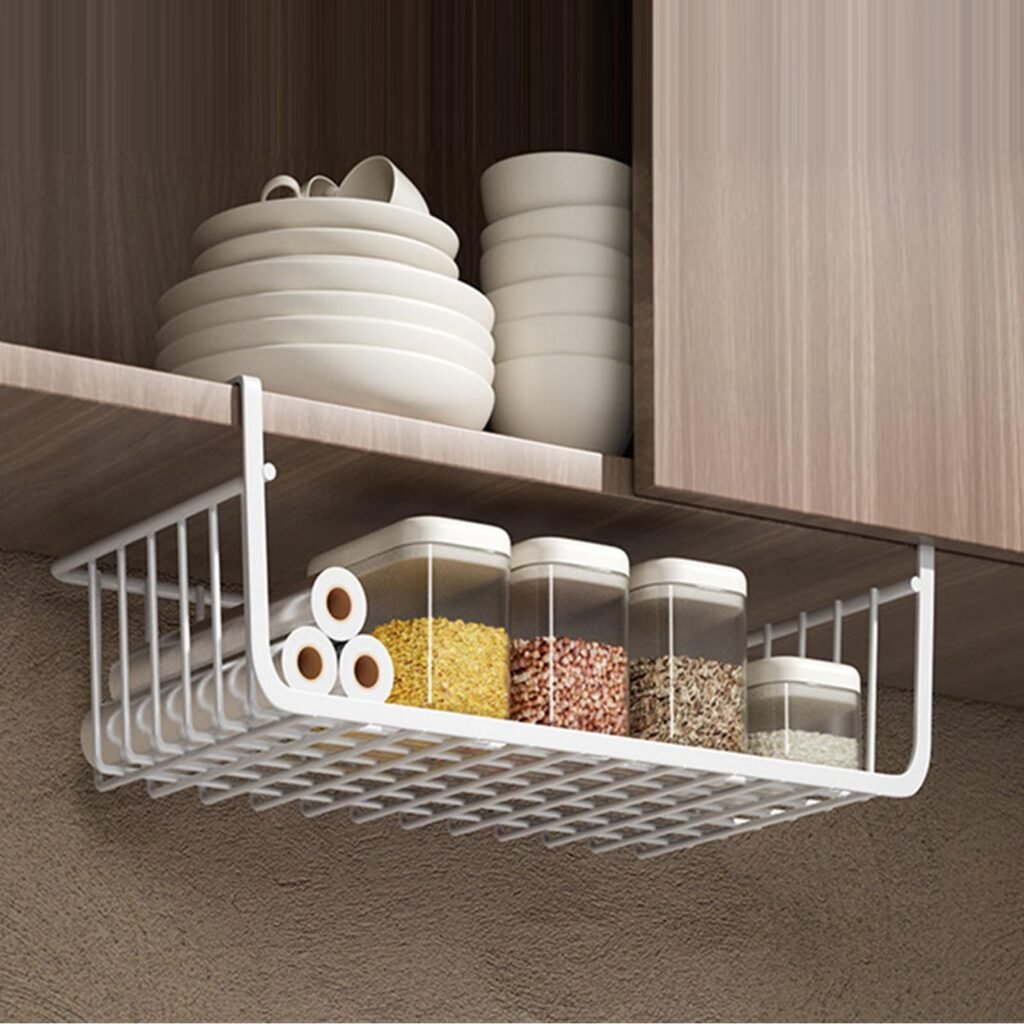
Under-shelf baskets are a smart and affordable way to double your storage space without adding more shelves. These wire or plastic baskets clip onto existing shelves and create an instant mini-shelf underneath, ideal for storing lightweight items like napkins, sandwich bags, wraps, or snacks. They’re particularly useful in upper cabinets or pantry shelves with unused vertical space.
By using under-shelf baskets, you take advantage of often-wasted airspace between shelves. This not only helps organize smaller kitchen items but also keeps high-traffic zones tidy and prevents things from piling up. You’ll be amazed at how much more you can store when every inch is put to work.
Look for baskets that are sturdy yet easy to remove and reposition. You can mix and match different sizes depending on your needs. In a small kitchen, every square inch counts, and these baskets provide a low-effort, high-reward way to expand your kitchen’s functionality.
10. Designate a Coffee or Beverage Station
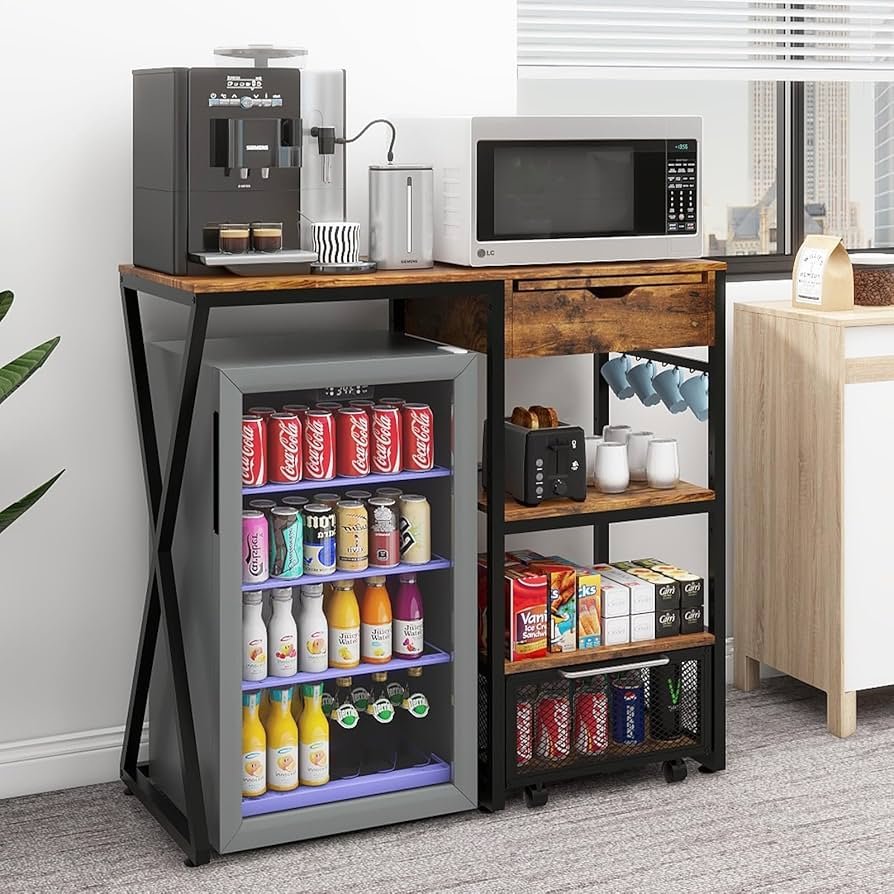
Creating a dedicated beverage station not only adds charm to your kitchen but also streamlines your morning routine. Whether you’re a coffee lover, tea enthusiast, or smoothie drinker, gathering all your supplies in one zone keeps things tidy and eliminates the hunt for filters, mugs, or syrups every morning.
Use a tray or rolling cart to define the space, then add a tiered organizer, drawer dividers, or canisters to hold pods, sweeteners, and stirrers. Wall-mounted racks for mugs or open shelving for flavor syrups can add both function and flair. This area can be as compact or expansive as your kitchen allows.
The key to a successful beverage station is easy access and clear organization. Consider placing it near an outlet so your coffee machine or kettle is always ready. It’s a great way to reclaim counter space elsewhere and give your kitchen a boutique café vibe right at home.
11. Use Door-Mounted Organizers
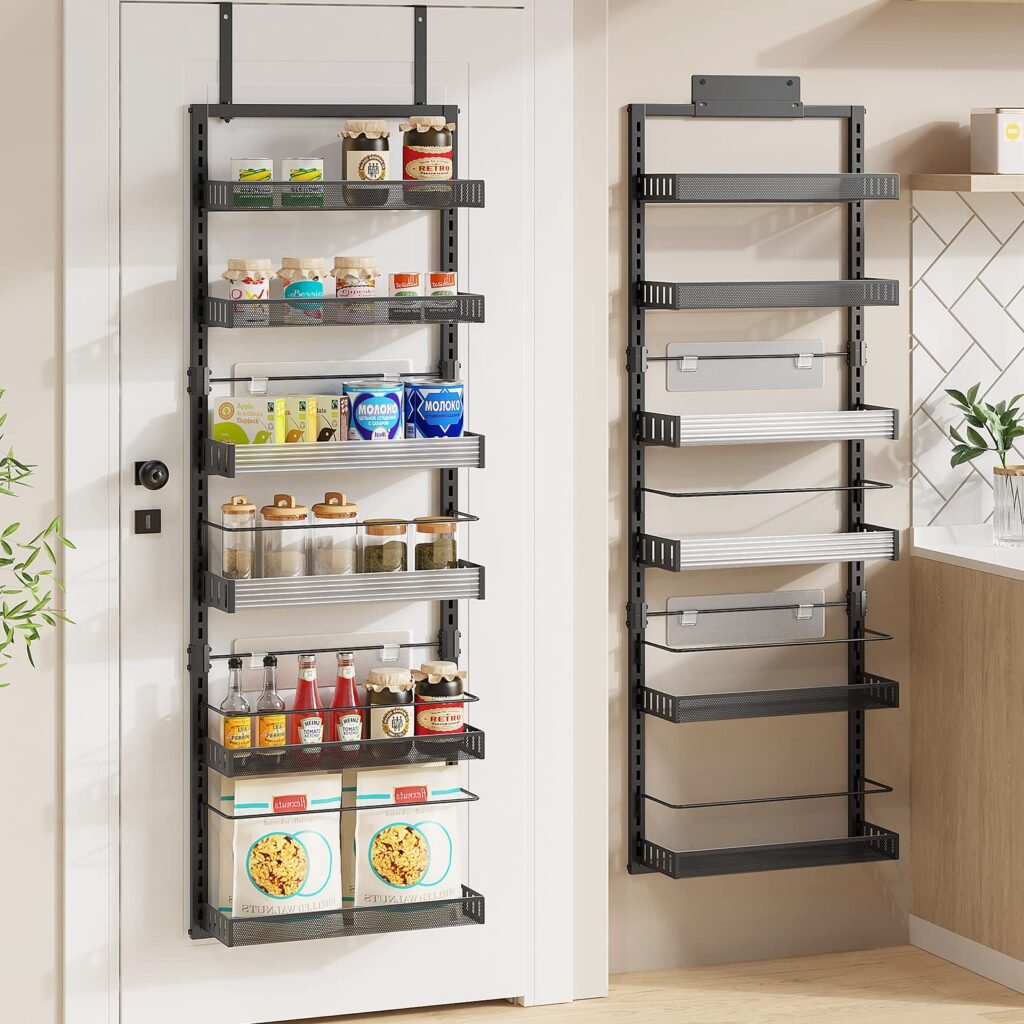
Don’t let the inside of your cabinet doors go to waste—these surfaces are prime real estate for slim storage solutions. Door-mounted organizers can hold cutting boards, pot lids, measuring spoons, spices, or cleaning supplies. With the right setup, you can create a home for items that often clutter drawers or countertops.
These organizers come in a variety of styles, including baskets, racks, and caddies. Some simply hang over the door, while others can be screwed in for a more permanent option. Look for ones with adjustable height and compartments that match your storage needs.
Using this hidden space keeps essentials accessible without sacrificing cabinet interiors. It also makes cleaning supplies safer and easier to grab, especially if you have kids or pets. Just a few additions can drastically improve the flow and tidiness of your kitchen setup.
12. Create Zones for Efficiency

Dividing your kitchen into zones based on activity is a pro-level organization tip that changes how you use your space. Typical zones include prep, cooking, baking, cleaning, and storage. Each area should house everything you need for that task—so you’re not walking across the kitchen for a spatula while something’s boiling.
For example, your prep zone should have cutting boards, knives, mixing bowls, and a trash can nearby. A baking zone might contain measuring cups, mixing spoons, a stand mixer, and commonly used ingredients like flour or sugar. Keeping items in the zone where they’re used the most increases efficiency and saves steps.
This approach reduces clutter, minimizes decision fatigue, and makes your kitchen more intuitive for guests or family members. Label drawers or shelves if needed, and rearrange things until your flow feels natural. Once set up, you’ll find your time in the kitchen feels smoother and less stressful.
13. Hang Utensils or Pots and Pans
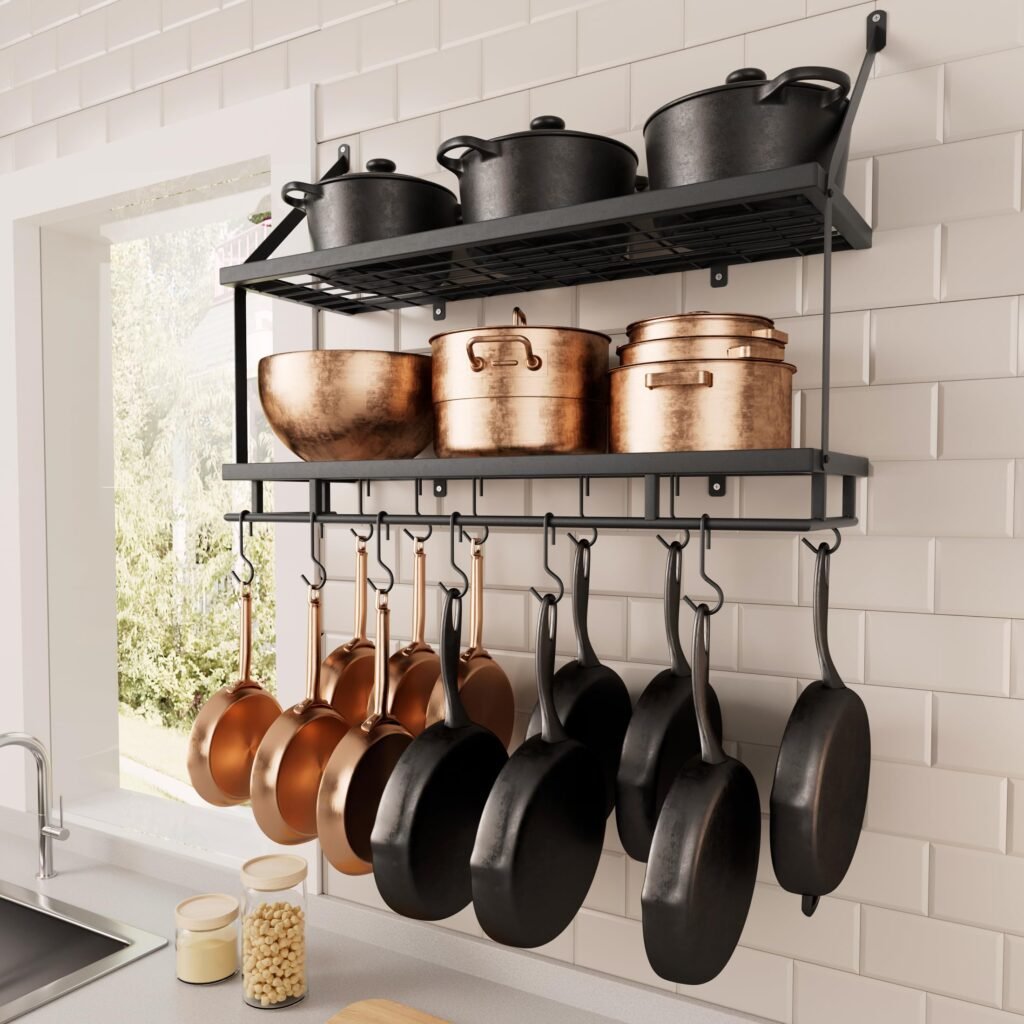
Free up drawer and cabinet space by hanging utensils or pots and pans. Wall-mounted bars or ceiling-mounted pot racks can hold these bulky items in plain sight, doubling as décor and function. Hanging storage is ideal for kitchens with limited cabinetry or those looking to add a chef’s kitchen vibe.
S-hooks are a popular, flexible option for hanging items on rods or racks. Arrange your tools by size or type, and keep everyday essentials like spatulas and ladles within easy reach. If you have a stylish set of cookware, this is your chance to show it off while saving valuable storage space.
You can mount racks on the backsplash, on a side wall, or even inside an island if you prefer a lower profile look. This not only declutters your kitchen but also keeps tools right where you need them—cutting down on time spent searching and cleaning up after cooking.
14. Label Everything

Labels are a small detail that make a big difference in maintaining an organized kitchen. When every container, drawer, and shelf is clearly marked, it’s easier to find what you need and just as easy to put it back in the right place. Labeling helps keep your entire household on the same page, too.
Whether you use a label maker, chalkboard stickers, or handwritten tags, consistency is key. Labeling dry goods like flour, grains, and snacks can also prevent cooking mishaps—no more mistaking powdered sugar for baking soda! Plus, labeled bins in the fridge or pantry make restocking a breeze.
It’s also helpful for organizing leftovers, condiments, and meal prep items. You can even date your labels to track freshness. While it might seem like a minor step, labeling builds habits that keep your kitchen functional and clutter-free for the long haul.
Final Thoughts
These 14 genius kitchen organization ideas prove that you don’t need a complete remodel to make your kitchen more functional. With a few clever tools and strategic changes, you can transform even the messiest space into an efficient, inspiring place to cook and gather.
Whether you try just one idea or go all in, your kitchen will become more user-friendly—and maybe even a little more fun to be in. Ready to reclaim your counters, drawers, and cabinets? Start organizing today and enjoy a kitchen that truly works for you.

